
Pope Alexander VI was head of the Catholic Church and ruler of the Papal States from 11 August 1492 until his death in 1503. Born into the prominent Borgia family in Xàtiva in the Kingdom of Valencia under the Crown of Aragon, Rodrigo studied law at the University of Bologna. He was ordained deacon and made a cardinal in 1456 after the election of his uncle as Pope Callixtus III, and a year later he became vice-chancellor of the Catholic Church. He proceeded to serve in the Curia under the next four popes, acquiring significant influence and wealth in the process. In 1492, Rodrigo was elected pope, taking the name Alexander VI.

Pope Callixtus III, born Alfonso de Borgia, was head of the Catholic Church and ruler of the Papal States from 8 April 1455 to his death, in August 1458.
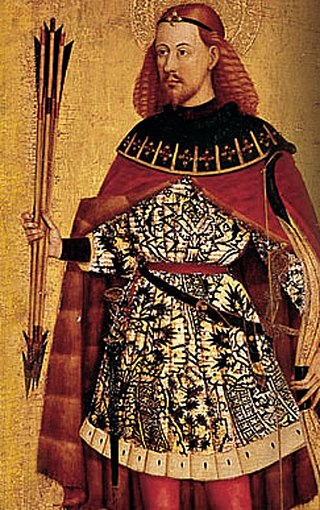
Ausiàs March was a medieval Valencian poet and knight from Gandia, Valencia. He is considered one of the most important poets of the "Golden Century" of Catalan/Valencian literature.

Gandia is a city and municipality in the Valencian Community, eastern Spain on the Mediterranean. Gandia is located on the Costa del Azahar, 65 kilometres (40 mi) south of Valencia and 110 km (68 mi) north of Alicante. Vehicles can access the city through road N-332.

The House of Borgia was a Spanish noble family, which rose to prominence during the Italian Renaissance. They were from Xàtiva, Kingdom of Valencia, the surname being a toponymic from the town of Borja, then in the Crown of Aragon, in Spain.

Safor is a comarca within the province of Valencia, Spain. The capital is the city of Gandia, but also includes the towns of Oliva, Piles and Daimús, among others. The beach area of Gandia, La Platja, is well known for its wild nightlife during the summer.

Xàtiva is a town in eastern Spain, in the province of Valencia, on the right (western) bank of the river Albaida and at the junction of the Valencia–Murcia and Valencia Albacete railways. It is located 25 km west of the Mediterranean Sea. During the Al-Andalus Islamic era, Arabs brought the technology to manufacture paper to Xàtiva. In the 12th century, Xàtiva was known for its schools, education, and learning circles. Islamic scholar Abu Ishaq al-Shatibi's last name refers to Xàtiva where he lived and died. After the Reconquista by Northern Christian kingdoms and the following Christian repopulation, the city became the cradle of one of the most powerful and controversial families of the Renaissance, the House of Borgia, which produced Popes like Callixtus III and Alexander VI.

Duke of Gandía is a title of Spanish nobility that was first created in 1399 by Martin of Aragon and granted to Alfonso of Aragon and Foix. It has its origin in the lordship of Gandía created in 1323 by James II of Aragon. Later, having no direct descendants, the title passed from the House of Barcelona to the House of Trastámara.

Spanish Gothic architecture is the style of architecture prevalent in Spain in the Late Medieval period.

The Monastery of Sant Jeroni de Cotalba is a monastic building of Valencian Gothic, Mudéjar, Renaissance, Baroque and Neoclassical styles constructed between the 14th and 18th centuries, located in the municipal area of Alfauir, (Valencia), Spain, about 8 km. from the well-known city of Gandia.
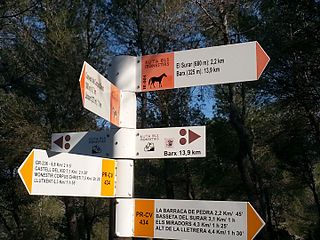
The Route of the Monasteries of Valencia (GR-236) is a religious and cultural route that connects five monasteries located in central region of the Province of Valencia,, in Spain. The Route was inaugurated in the year 2008.
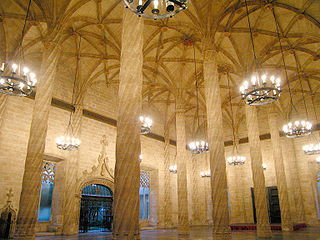
Pere Comte was a catalan architect from Girona. He was one of the main Gothic architects of the Crown of Aragon of the period, and in particular in Valencia, where he directed the construction of numerous palaces. Pere Compte is considered a master of the Valencian Gothic art.
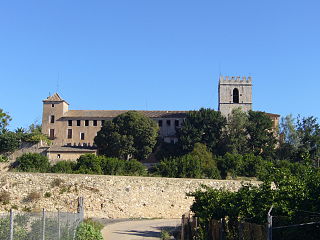
The route PR-CV 100 is a short-distance footpath of the Valencian Community (Spain) that goes from Ròtova (Valencia) to the Monastery of Sant Jeroni de Cotalba, in Alfauir (Valencia), crossing different natural places and monuments, saws, rivers, etc., all of them of great landscape and cultural interest.

María Enríquez de Luna was the wife of Juan (Giovanni) Borgia, second Duke of Gandía. Her father was, Enrique Enríquez de Quiñones, making her paternal grandfather Fadrique Enríquez. Her aunt, Juana Enríquez, was Queen of Aragon by marriage to John II of Aragon. Therefore, she was a first cousin of King Ferdinand II of Aragon. She married Juan somewhere between 1493 and 1494, and together, they had two children: Juan de Borja y Enríquez, who became the 3rd Duke of Gandía, and Isabel de Borja y Enríquez, who was born shortly after her father was killed and never knew him. The younger Juan was the father of Saint Francis Borgia. Isabel grew up to be abbess of Santa Clara in Gandía. In personality, María was very intelligent, devout, financially shrewd, and devoted to her husband and children, in contrast to her husband, who was regarded by many as a womanizer, a gambler, a drunkard, and an incompetent general.
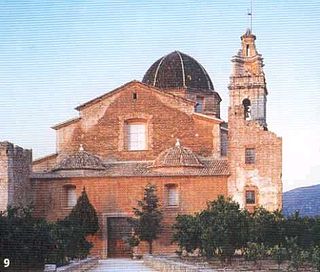
The Monastery of Santa Maria de Valldigna is located in Simat de la Valldigna (Valencia).
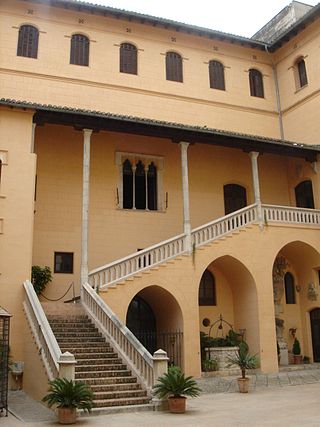
The Ducal Palace of Gandia was, from the 14th century, the residence of the Royal Dukes of Gandía, and from 1485, the Borja family. It was the birthplace of Saint Francis Borja.

The Collegiate Basilica of Santa Maria of Gandia, also known as "La Seu", is the principal church of the city of Gandia, (Valencia). Construction commenced in the 14th century.

The Oratory of the Borgias or Church of the Tower is located in the municipality of Canals (Valencia), Spain. It is a church built in early Valencian Gothic style, probably in the 13th century.

The Route of the Valencian classics,, is a cultural route through the lands of the great classical writers of the Valencian literature of the Valencian Golden Age: Ausiàs March, Joanot Martorell and Joan Roís de Corella, the three related to the court of the Duke Alfonso of Aragon and Foix, "the Old".

Valencian Gothic is an architectural style. It occurred under the Kingdom of Valencia between the 13th and 15th centuries, which places it at the end of the European Gothic period and at the beginning of the Renaissance. The term "Valencian Gothic" is confined to the Kingdom of Valencia and its area of influence, which has its own characteristics.




























